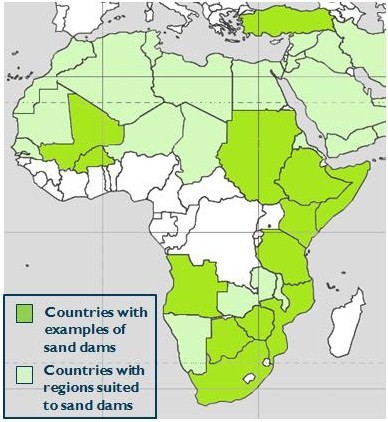|
Sand dam
Sand dams are a simple, low-cost and low-maintenance, replicable rainwater harvesting technology. They provide a clean, local water supply for domestic and farming use and are suited to semi-arid areas of the world. OperationA sand dam is a reinforced concrete wall (or a similarly robust and impermeable weir) built 1–5 metres high across a seasonal sand river. When it rains the dam captures soil laden water behind it – the sand in the water sinks to the bottom, whilst the silt remains suspended in the water. Research on Kenyan dams shows that only 1 to 3% of rainwater is retained behind any individual dam, the remainder continues its natural flow towards the ocean.[1] Eventually the dams fill with sand - sometimes after only one rainfall or over 1 – 3 seasons. 25 to 40% of the volume of the sand held is actually water. A mature sand dam can store millions of litres of water – refilling after each rainfall providing a year round supply of clean water to over 1,000 people. ApplicationThe highest concentration of sand dams with the strongest track record is found in Kenya although examples are found throughout world’s semi-arid regions from Angola to Zimbabwe. Further examples are recorded in Japan, India, Thailand, SW USA and Brazil. Sand dams can be built in the upper and middle courses of seasonal sandy river valleys (also known as wadis). Typically, sand dams are built in the transition zone between hills and plains where the gradient of the river bed is between 0.2 - 4%, but in extreme cases sand storage dams have been constructed on slopes of 10-16% (Nilsson 1988). Dams must be built on bed rock or highly compacted sub-soil. For the obvious reason of economy on materials and labour, the stream must be reasonably narrow with well defined and stable river banks and the bedrock or impermeable subsoil within a few metres of the stream bed. Rocky banks and gorges are the most apt features. Further advice on the siting, design and construction of sand dams is available from the organisations and in the manuals listed below Extracting stored waterThere are two simple ways:
Benefits
Case Study: A socio-economic effort at Community Development in Kitui, KenyaOn a global scale climate change and effects there of have exerted tremendous pressure on the biophysical, economic, political and social systems that govern the sustenance of a majority of African populations. (Zierrogel et al, 2009) “Climate Change is expected to intensify existing problems and create new combinations of risks, particularly in Africa where there is widespread poverty and dependence on the natural environment.” (Zierrogel et al. 2009) Kitui is a region in Eastern Kenya, East Africa, where the sand dam project has been relatively more successful in comparison to other regions that adopted the same or similar systems. The Kitui region has approximately five hundred functional sand dams that help with water storage for subsistence and commercial purposes for example irrigation, domestic use and for feeding and sustaining livestock. (Maurits, 2008) Effectiveness of Sand Dams in Kitui With the setup of over 500 dams in the region there is no question to how these sand dams are a major community requirement. The image below shows an overview of the multiple uses of sand dams in the Kitui region. (Lasagne, 2008) Image: Table showing Sand Dams use in Kitui (Lasagne, 2008)  Human welfare:- these dams provide water security during the dry season when numerous rivers and wells dry up due to the harsh conditions of the region. (Lasagne, 2008) Quality of nature:- The dams provide water to the ecosystem by feeding the water table hence trees and flora are able to thrive in the surrounding areas. (Lasagne, 2008) Food capacity:- Due to access to water reserves numerous individuals engage in subsistence and semi-commercial farming which creates a source of income and livelihood for the Kitui People. (Lasagne, 2008) Industrial use:- On a larger scale these dams provide water for industrial capacity as individuals are able to engage on economic activities such as charcoal production, basket making and brick laying which creates a semi-stable source of income for the locals. (Lasagne, 2008) Hindrances to the sand dam project There are numerous obstacles to the sand dam projects but the major ones that stand out are irregularity of the rainy seasons, slow funding, lack of communal platforms to run the projects and maintain them. (Lasagne, 2008) Conclusion “The average income of farmers using sand dams rose with 9000 KSh. (USD 120), while less than 3% of total runoff is used. It is estimated that in 10 years time, more than 100,000 people have better access to water through low cost measure at an investment of about 35 USD per capita.” (Lasagne, 2008) If these projects had more government, Non-governmental participation and an increased community involvement, Kitui could be a world renown model for the ability of rural communities to combat drought , famine and other effects of climate change. Sand dam building organizations
Polish Humanitarian Action building dams in Kenya and Madagascar References
Bibliography
External links
|
Portal di Ensiklopedia Dunia






